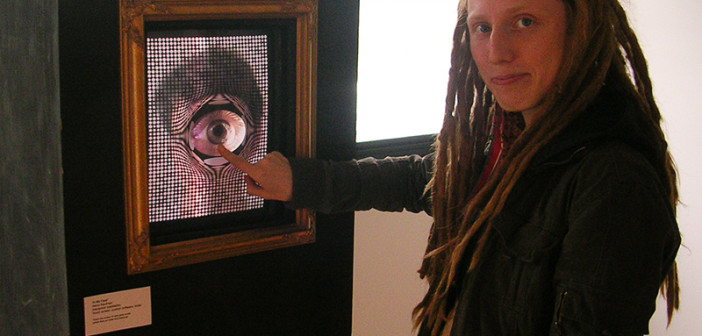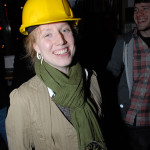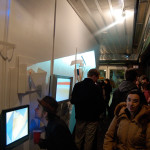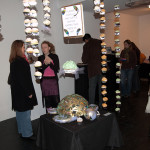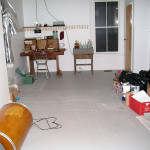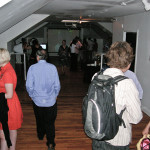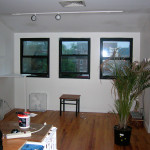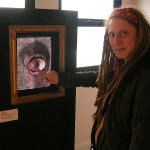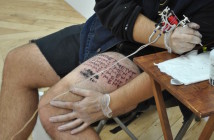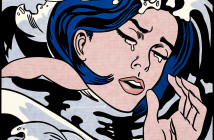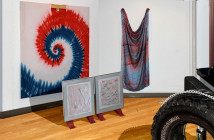Heidi Kayser is a curator, artist, programmer and the founder of Axiom Center for New and Experimental Art. She was also the Associate Director of the Boston Cyberarts Festival. In August of 2012 Heidi decided to leave Boston to study at the MFA program at University of California, San Diego. James Manning spoke with Heidi about her experiences in the Boston art scene, going full circle from her beginnings as an intern at Oni Gallery to running her own alternative space.
James Manning In 2003 while you were a student at MassArt, Oni Gallery was at its zenith as the epicenter of the Boston alternative arts scene. How did you start out as an intern at Oni and how you were involved when they got shut down?
Heidi Kayser The more I look back, the more I realize how much Oni Gallery opened my eyes, as I knew nothing about the art scene before that. After dropping out of school studying both classical music and biology, I wanted something more creative. I decided to apply for the Studio for Interrelated Media (SIM) program at MassArt. I liked how they really encouraged people to go out and make their own path and part of that was letting you organize events and projects on your own. Not knowing anything about how the art world worked, I wanted to learn from people who did things in the real world outside of school and that led to my doing an internship at Oni.
When I started there I had no idea what an alternative space was, and I was instantly immersed in this crazy collective of artists in Chinatown with studios, a performance space and gallery with events going on all the time. My jobs as an intern ranged from cleaning up the space, setting up chairs in the theatre, making popcorn, updating the website and documenting events; basically any odd job that needed to be done.
All of a sudden Oni was shut down, at the time I was only 23 and pretty naive about the situation and did not realize how complex the issues were between the landlord, inspectional services and the other agencies at the City and State that caused all the problems. For a while, I really thought that things would work itself out and that Oni would quickly reopen. That of course did not happen. As that situation unfolded, I began to focus on my classes and moved on from Oni.
JM So how did your experience at Oni lead into your starting Axiom?
HK Because of what I was exposed to at Oni, I began exploring other alternative spaces and going to shows and events at Mobius, Zeitgeist and Art Interactive and the idea began to form that I should start my own space.
In the fall of 2004 while still at MassArt, I partnered with 3 other students and opened a space on Harvard Ave. in Allston. At first the idea was to just to show our friends from school.
This evolved as one of my class projects, an online digital and new media art gallery I called Axiom, began to take shape. As this online gallery developed I heard about the Boston Cyberarts Festival and realized that I had a space to do this project as part of the festival. I met with Catherine D’Ignazio, who at the time was the Exhibitions Director at Art Interactive, and with George Fifield, Director of the Boston CyberArts Festival, both of whom gave me great advice about how to start a gallery space focusing on new media.
The first show at Axiom was a mix of MassArt graduate students and faculty and it was a great success. Unfortunately right after this problems between my partners led to the loss of most of the funding and a second show in August 2005 turned out to be the last in that space. As I began to get attention for these shows I wanted to get more serious but still did not know that much about the business side of things. I had Kathy Bitetti of the Artist Foundation help me organize as a 501(c)(3) non-profit and I began applying for grants, unsuccessfully at first because of the instability in the group.
Coincidentally at the same time I lost the space in Allston, Zeitgeist was evicted from its space in Cambridge. They ended up renting an office space just outside of Inman Square, but could not afford the full rent themselves. So they then approached me and we decided to split the space. We started out alternating each month between Axiom and Zeitgeist. At first this seemed like a good idea, but in practice it didn’t work to split a space like this. We were very different minded organizations with different goals for how to use the space. Zeitgeist wanted to do more regular programing of events like yoga classes or concerts which would often conflict with exhibit installations that Axiom set up in the space. By the fall of 2006 I decided to move on.
Again by coincidence, James Hull had decided to move on from running the Green Street Gallery in Jamaica Plain and he approached me about taking over the space. I signed the lease and moved in to Green Street. It was around this time I also formalized my partnership with Phaedra Shanbaum, who became co-director of Axiom. Phaedra was also the Assistant Director of the Boston Cyberarts Festival and had helped me out with some of the exhibitions at the Inman Square space.
JM Axiom evolved through your collaborations at MassArt, in particular the SIM program. You also exhibited your own art as part of the Collision Collective, a group that has shown regularly at Axiom (and continuing at the Boston Cyberarts Gallery). How did your involvement with these groups shape your concepts for Axiom as it emerged?
HK I became involved with the Collision Collective before Axiom. While I was a student I went to one of their meetings, and I remember just being in awe of the fact I was in the same group as all these PhD’s and computer scientist making art. I learned from them and they were impressed with my work. I was accepted to participate in one of their early shows at Art Interactive. Since I was considered part of the group it just felt a natural progression to have shows with them at Axiom later on after Art Interactive closed.
The reason I started Axiom under the tagline of "Center for New and Experimental Media" is that I did not want to limit myself using the word ‘new media’ because I felt it was not inclusive enough. I wanted to open it up more to include things such as technology in combination with something like performance, things that may not be considered ‘new media’ by critics and theorist. I wanted it to be a place for people to take risks and focus on the experimental aspect. I was interested in pushing the boundaries of what could be considered art and the crossover that could happen between different disciplines of computer science, music, dance and artificial intelligence and how all those things could all be brought together in to the art realm.
JM So how did you pull it all off? How did you manage the challenges between running the organization, installing and managing shows and still having a job so you could pay for it all?
HK I really felt what I was doing was important work, not just for myself but for a lot of different people involved. Knowing I was making a difference and that the artists were so thankful is what kept me interested and motivated to do more. I started to get more recognized for Axiom and began making more of my own connections in the community which was also a force to keep me going.
As Axiom grew people who were already established, like George Fifield, became more involved in part because they wanted to help the next generation along. George was also a mentor to me as a curator, helping me gain access to artists through his connections. We began collaborating on shows. This eventually led to the Axiom/ Boston Cyberarts merger in 2009 and to my becoming the Associate Director of the Cyberarts Festival.
When I graduated from MassArt I took on many jobs to get by, I was a studio manager for a sculptor and also working as a waitress. Henry Kaufman one of my teachers who taught me Flash programming, and whom I showed in the first Axiom show, came in one day at the bar I was working at and told me I was wasting my talents as a waitress and that he believed in me as an artist and a curator. He connected me to a freelance job as a multimedia programer and I quit waitressing. It was at this job I taught myself more advanced programming and animation as I designed interactive kiosks for museums. I was also able to use much of the money from this job to fund Axiom. I also began reading up on non-profit management and accounting. A lot of what I did in terms of learning how to run the gallery, I did on my own, researching and reading as much as I could and getting advice from friends when needed.
I think one of my strengths that emerged while running Axiom was organizing people, particularly in small groups. This really helped me get out of my personal bubble as I tend to be a rather shy person. I liked that feeling of working with others and being the organizer that makes things happen.
We had a lot of students who came for internships. Even if they were not getting credit they wanted to be volunteer or just be involved. At first everybody did everything, we all showed up on a Saturday and I showed them how to paint walls and how to hang art; we had fun and had beers. The problem was that this did not keep people interested for a long time because this approach did not have something to offer them in return as a motivating force, and I would end up doing much of the work myself. So we changed the system to have volunteers with specific tasks and titles, such as Marketing Director or Education Coordinator, or curators for specific programs. This way they were motivated and has a sense of ownership with their roles. So instead of a few weeks or months previously, our volunteers would stay on for a year or longer.
For a few years this worked well, but as the group began to grow too many people got involved, up to a dozen. Making decisions became a lot like being in a jury, a lot of ideas were thrown out there at meetings, some were written down, but not many would be followed up on and actually executed because there were so many voices. In the end it always came down to me and a couple of the core people doing the actual work.
In the Summer of 2011 half the group left as they went on to grad school or teach. I thought about trying to rebuild again, but at the same time I also began to think about my own future and decided that I wanted to focus on my own art and grad school and my interest in running a gallery was just not there anymore.
After considering all of the options, it was decided the gallery would be handed off to Boston Cyberarts, which worked out as Cyberarts was going through its own transition with the festivals ending.
JM Looking back, what are your thoughts having come full circle, from a student, to being an intern at Oni, to running your own space with interns of your own?
HK To me it was a natural progression and it never really occurred to me that I was going through all these steps, it just happened. I don’t think I could have done any of this had I not started out as an intern at Oni and gotten that early experience. While running Axiom, I also began teaching at Mass Art, this only happened because the professors there, particularly Dana Moser and Nita Sturiale, had seem my work evolve and believed in me and gave me a chance. That put me on the other side of the coin so I was now the teacher instead of the student and I was now the director instead of the intern.
What is most interesting to me now is that I have gone back to being a student. Now I am in the beginning of a new cycle in a new city.
I think that that even from my brief experience in San Diego, I can look back at and see how unique and rich Boston is and that people have such a determination to make things happen there. Between the institutions like MIT and all the art schools there is such a wealth of people doing creative things. It was amazing for me to be a part of that. Seeing all the spaces that come and go is sad for a while, but it seems to me that things keep happening. There were a lot of new spaces popping up I did not get to see before I left and I know people are continuing to do that. I am glad to know that things keep going to support all of the creativity happening in Boston.
- Heidi at the opening of Riders on The Train Axiom Green St. 2009
- Opening of iArt January 2007. First Axiom exhibit at Green Street Jamaica Plain.
- Axiom, Inman Square opening of Cake: The Delicious and Transient media. Fall 2006. Final Axiom show in Inman Square
- Axiom in Inman Square during an exhibit installation
- The opening of Mass Media at Axiom, 2005
- Axiom in Allston during the install of the exhibition ‘Mass Media’
- Heidi Kayser at the first exhibit at Axiom, Harvard Ave in Allston
All photos by Manning
For full archives of Axiom exhibitions visit
Axiom Gallery
To see Heidi Kayser's artwork visit
http://www.heidikayser.com/

